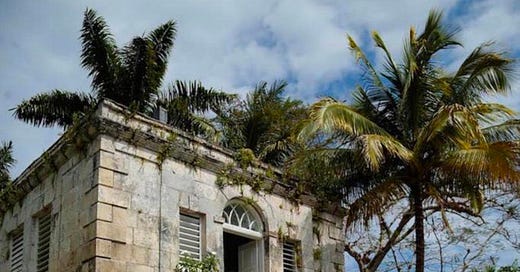Field Guide Vol. 242
Today is a very special day, it’s Leap Day! Every four years, February 29th comes around, sparking both curiosity and superstition. From unique proposal traditions to avoiding major life decisions, this rare occurrence holds a unique place in folklore and current day traditions and is intertwined with various superstitions around the world. Join us as we delve into the intriguing world of beliefs and omens in honor of this extraordinary date.
My Father’s Land
The indelible marks of slavery in Jamaica
By Courtney Desiree Morris
In January 2019, I dragged my father and husband to yet another great house. We traveled to the neighboring parish of Trelawney to visit the Good Hope estate. Once the largest plantation on the island, today Good Hope has become a popular tourist attraction that is run by Chukka Adventure Tours, a multinational corporation that provides short- and long-term excursions for travelers in exotic locales.
Our tour guide was named Crystal. She is what Black folks in the US call “thick,” curvy, with smooth, dark skin, a wide glossy smile and a pleasant demeanor. She led us up the front stairs into the gallery, a long corridor that stretches across the length of the house linking the formal and informal drawing rooms. She pointed out the original wild orange hardwood floors; the cloudy eighteenth century mirrorhanging on the wall opposite the entrance; the mahogany planter’s chairs on either side of the mirror, which she told us were measured to fit their original owners; the exquisitely carved side tables. She pointed out the cedar shingles in the formal drawing room that contract to allow the breeze to pass through the room during dry weather and expand to keep out rain.
Crystal led us from the formal living room to Tharpe’s bedroom and his wife’s private quarters. She made much of the mahogany bed frame, the authentic eighteenth century traveling valises stacked at the foot of the bed and the picturesque views of the valley below. We followed her into Tharpe’s bedroom and personal bathroom. She claimed that Tharpe built the first jacuzzi in the 1790s to deal with his arthritis and gout, a common malady of the planter class who led pampered lives eating rich food, drinking rum and wine and hosting enormous parties that lasted for weeks on end. Unfortunately, Crystal told us, Tharpe’s jacuzzi was lined with lead, and after several years of soaking in this artisanal hot tub, Tharpe died unwittingly at his own hand.
We exited Tharpe’s bedroom and stepped out onto the veranda, where a group of tourists was sitting down to an “authentic” English tea offered to visitors. Everyone seated was white. Everyone serving them was Black. As we passed them, their conversations turned suddenly quiet, and several guests shifted uncomfortably in their seats. I was preoccupied with my camera, and it took me a second to notice the subtle shift. When I looked up, I felt as though everyone was staring at me. I glanced at my father, who responded silently with a knowing, exasperated look on his face.
We sighed, turning our attention a few feet away to an imposing, elevated, one-story limestone structure with a wide staircase surrounded by towering palm trees: the Counting House. According to our tour guide, John Tharpe was many things—a philanthropist, an inventor, a successful businessman, and, apparently, deeply superstitious. Our guide told us that despite his success as a planter, Tharpe was supposedly uneasy having made his fortune on the backs of slaves. He did not like having his money counted in his home, so he built the Counting House as an office for his bookkeeper and never talked money or business inside his home.
During his lifetime, Tharpe enjoyed a reputation as a humanitarian who provided charitable aid to the poor and the enslaved. Crystal told us that Good Hope was the only plantation in the area that was not burned down during the 1831 rebellions, a reflection of the slaves’ regard for John Tharpe as a fair master. While the rebels burned down other plantations, she said that the slaves at Good Hope not only did not participate in the rebellion but continued working throughout the uprising.
Tharpe built a slave hospital with approximately 300 beds. It was later converted into a birthing center, and after emancipation, it was repurposed as a school. Today, it is an aviary. Crystal told us that Good Hope was the only plantation on the island that provided these services to slaves. She said Tharpe built the only slave hospital on the island because he “cared about his slaves.”
“I guess you could say he was a good slave master,” she said.
“Ain’t no such thing,” I retorted. She laughed, and I couldn’t tell whether she was nervous or if this was simply part of the tour guide script, or if she actually believed that Tharpe was a good slave owner in need of defending. “Even a farmer,” my father muttered, “take care of his animals.”
Did you know?
According to Celtic tradition, February 29 is the one day of the year where typical roles are reversed and women are encouraged to propose to men. This day is sometimes referred to in Ireland as “Bachelor’s Day” or “Ladies Privilege.” If the man rejects the proposal, he may face consequences such as bad luck or a fine.
Keep reading with a 7-day free trial
Subscribe to Stranger's Guide to keep reading this post and get 7 days of free access to the full post archives.




